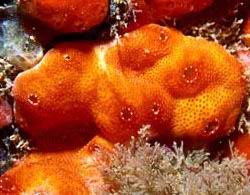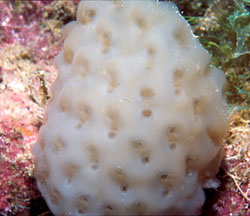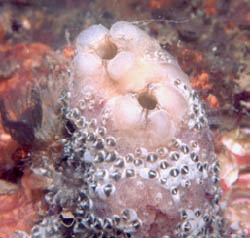|
You
are here: /main/research
expeditions/CReefs 2006/features/ascidians
Ascidians
(Sea Squirts)
Discussion
with Tito Monteiro da Cruz Lotufo, Universidade Federal
do Ceara, Brazil, Specialist in Ascidians, during the
2006
Census of Marine Life, Census of Coral Reefs expedition
to French Frigate Shoals
 |
An ascidian from the Atlantic Ocean,
Didemnum ligulum. Photo by Tito Monteiro da Cruz Lotufo |
Ascidians, also known
as sea squirts, are filter feeding marine animals frequently confused with sponges,
or even rocks, due to their appearance. They come in a variety of shapes and
sizes, and the majority are sessile (they do not move) and are attached to the
bottom, but a few deep water species can actually move and are predatory. They
live exclusively in marine waters, and they are our nearest relatives among the
invertebrates. They have a notocord (primitive spinal cord) as well as a narrow,
hollow neural tube running along the body (two defining features of chordate
animals, like humans). In the case of the ascidians these features disappear
in adult life when the larvae pass through a metamorphosis and most of the chordate
features are lost. This metamorphosis is different from all other animals in
that the ascidian larval stage is more biologically complex than the adult form
of the animal.
Ascidians are quite interesting because they have a tunic of living tissue that covers the entire animal, and the tissue matrix is made out of cellulose-like material, which is unusual for an animal. In the beginning of the 20th century scientists thought that this tunic material was actually cellulose (the main component of plant cell walls) but further studies have shown that the tunic material was not really cellulose, but a material very similar.
 |
An ascidian from the Atlantic Ocean, Stomozoa gigantea. Photo by Tito Monteiro da Cruz Lotufo
|
Ascidians
are also capable of accumulating a considerable amount of
heavy metals in
their blood, not the common metals abundant in sea water,
but rare metals in the ocean
environment such as vanadium, tantalium and titanium. The metals
don ’t
have a function like the iron in human blood that helps
with the transport of oxygen in hemoglobin. It seems that
these metals act in a process,
along with sulphuric acid that many ascidians have contained
in small vessicles, to polymerize (string together) carbohydrates
to make the cellulose
like fibers on the tunic, a material called tunicin. This
fibrous material encapsulates the animal and forms a semi-rigid
exoskeleton. It also offers
some protection from predators, with some species even
developing tunics with spikes and other defensive adaptations.
Additionally the tunicin
fibers help to attach the organism to the substrate.
Another interesting feature of ascidians is that they are the only animals living that can actually reverse the direction of blood flow in their circulatory system. The ascidian heart has two different pace makers, one on each end and they alternate in dominance. Blood flows in one direction, and every few minutes it will slow down, and then flow in the opposite direction. There is no other known animal that exhibits this trait.
The
ascidians are widespread in all the world’s oceans and
seas, from the equatorial to the polar regions, and have
been found at depths down to 8000 meters. They have been
quite successful as a group of animals, and are very
efficient filter feeders. One solitary ascidian, 8 cm
long, has been observed to pump three or four liters
of water per hour across their body cavities. The primary
food of ascidians is phytoplankton, which they filter
from the water.
Ascidans are generally colonial organisms but can also be solitary. For the solitary forms, reproduction is in the water column, and their solitary gametes go into the water where fertilization occurs. The colonial forms brood their larvae inside their bodies until they are ready, then the larvae leave the colony and enter the water column. At first the tadpole shaped larvae swims up, towards the light, and gets carried away from the colony by the currents, but after several minutes the larvae change direction and seek a suitable habitat on the bottom, preferably a dark spot, under a boulder or under an overhanging reef where they attach and begin to grow. Since the larval stage is such a short part of their life cycle, and it only travels a short distance from the parent organism before settling, it limits the ability of ascidians to quickly disperse over a broad area.
 |
An ascidian from the Atlantic Ocean, Styela plicata. Photo by Tito Monteiro da Cruz Lotufo |
There are only a few individuals
working on ascidian ecology today, and on the role of acidians
in coral reefs. Depending on the type of reef, ascidians
may be quite abundant. They may serve as a food for many
fishes, or other invertebrates. Many of the ascidians have
symbiotic relationships with algae, much like corals do
with their zooxanthellae, but ascidians have a different
type of algae called prochloron, a green algae that is
actually more like a bacteria than a true algae. Most of
the volume of the ascidian organism is occupied by a basket
which filters the food from the water, and the interior
of this basket provides excellent habitat for many other
species such as alpheid shrimps. There are also two families
of copepods, small crustaceans, that specialize in living
inside these baskets.
I chose to study ascidians because they are weird and have so many strange features, like being related to vertebrates, and they have so many distinguishing features such as the heavy metal concentrations, and the ability reverse their blood flow. Also, there are so many species of ascidians, and we know very little about them.
Since French Frigate Shoals, Hawaiian Islands National Wildlife Refuge and Northwestern Hawaiian Islands Marine National Monument, is a very remote location, and ascidians are not able to disperse long distances, I expect to find a number of new species, especially in the cryptic or smaller forms, which may not have gotten the attention of other people working in the area. We have found many new species along the Brazilian coast where I work, and even new genera. We have also found many new species and new forms in the Gulf of Mexico, which is arguably the best-studied marine area in the United States. So, there is a really good chance I am going to find new species of ascidians on this expedition.
References:
Tito Monteiro da Cruz Lotufo, Universidade Federal do
Ceara, Brazil. Personal communication aboard the NOAA
ship Oscar Elton Sette, October 2006.
Coral Reef Ascidians of New Caledonia. Monniot, Claude,
et. al., Paris 1991. ISBN: 2-7099-1050-0
*All images and information from French Frigate Shoals are provided
courtesy of the Northwestern Hawaiian Islands Marine National Monument,
Hawaiian Islands National Wildlife Refuge, the Northwestern Hawaiian
Islands State Marine Refuge, and NOAA's Pacific Islands Fisheries
Science Center in accordance with permit numbers NWHIMNM-2006-015,
2006-01, 2006-017, and DLNR.NWHI06R021 and associated amendments.
Click
on one of the following areas to follow the expedition.
Ship
Logs:
Day-by-day
activities of the ship: what research is being done that
day, what the weather is like, what's for dinner, etc.
Journals:
Daily
or semi-daily personal journal entries by the particpants
in the expedition. These journals do not necessarily reflect
the positions of any of the agencies connected with this
project.
Interviews:
Interviews with expedition participants, scientists,
vessel crew, educators, etc.
Features:
Highlights or special information such as interesting
discoveries or related research.
|